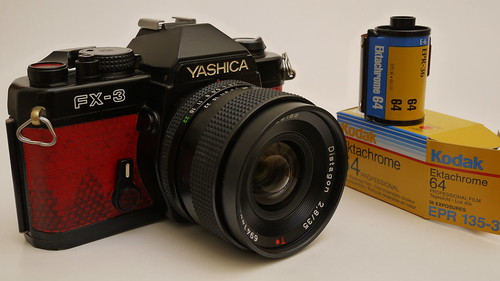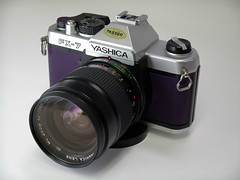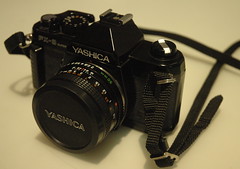Difference between revisions of "Yashica FX-3"
Hanskerensky (talk | contribs) (Added link to review) |
|||
| (4 intermediate revisions by 3 users not shown) | |||
| Line 1: | Line 1: | ||
| + | __NOTOC__ | ||
{{Flickr_image | {{Flickr_image | ||
|image_source= http://www.flickr.com/photos/zuiko21/4739456910/in/pool-camerawiki | |image_source= http://www.flickr.com/photos/zuiko21/4739456910/in/pool-camerawiki | ||
| Line 7: | Line 8: | ||
|image_rights= with permission | |image_rights= with permission | ||
}} | }} | ||
| − | The '''FX-3''' was a very popular, manually-operated, [[35mm]] [[SLR|single lens reflex]] camera, released by [[Yashica]] in 1979 | + | The '''FX-3''' was a very popular, manually-operated, [[35mm]] [[SLR|single lens reflex]] camera, released by [[Yashica]] in 1979<!--and built by [[Cosina]] **this requires a citation. It differs in numerous ways from the Cosina CT1 Super descendants** -->. It has a vertical metal-bladed mechanical [[focal plane shutter]] with speeds up to 1/1000, an [[Light meter|exposure meter]] with a simple 3-LED reading in the [[viewfinder]], and no automatic metering or focusing modes. The camera is very compact and lightweight for an SLR design, and weighs about 1 pound (450 grams). One of the camera's greatest attributes is that it will accept all manual-focus [[Contax/Yashica lenses]], including the superb Carl Zeiss T* lenses intended for the Contax line. The FX-3 was available only in black, though there was also an otherwise identical '''FX-7''' model that came in a chrome finish. |
In 1984 the FX-3 was replaced by the '''FX-3 Super''', that added a vestigial grip to the body, a flash-ready indicator in the finder, and moved the meter switch to the shutter release button. It too was only sold in black finish. Kyocera (which had acquired Yashica in 1983) released the '''FX-7 Super''' in 1985, exactly the same camera finished in chrome. | In 1984 the FX-3 was replaced by the '''FX-3 Super''', that added a vestigial grip to the body, a flash-ready indicator in the finder, and moved the meter switch to the shutter release button. It too was only sold in black finish. Kyocera (which had acquired Yashica in 1983) released the '''FX-7 Super''' in 1985, exactly the same camera finished in chrome. | ||
| Line 14: | Line 15: | ||
These inexpensive cameras have developed a reputation for reliability, mostly due to their extremely simple construction and durable metal chassis with plastic outer shell. The leatherette exterior covers of the FX-3 tend to disintegrate after a few years, but are easily replaced. Later Super 2000 models were sourced from China, and some components were changed to lower costs. | These inexpensive cameras have developed a reputation for reliability, mostly due to their extremely simple construction and durable metal chassis with plastic outer shell. The leatherette exterior covers of the FX-3 tend to disintegrate after a few years, but are easily replaced. Later Super 2000 models were sourced from China, and some components were changed to lower costs. | ||
| − | + | ||
{|class=floatleft | {|class=floatleft | ||
| | | | ||
| Line 55: | Line 56: | ||
|} | |} | ||
{{br}} | {{br}} | ||
| − | |||
== Specifications == | == Specifications == | ||
{| border="1" cellpadding="2" style="margin: 0.5em 2em; text-align: center; border-collapse: collapse;" | {| border="1" cellpadding="2" style="margin: 0.5em 2em; text-align: center; border-collapse: collapse;" | ||
| Line 78: | Line 78: | ||
|} | |} | ||
{{br}} | {{br}} | ||
| − | |||
| − | |||
== Notes == | == Notes == | ||
| − | |||
According to a 1980 review in UK magazine Practical Photography, Yashica/Cosina skimped on the FX-3/FX-7 metering circuity. Readings are accurate through the whole range at 100 ASA, but with higher film speeds they become incrementally inaccurate at lower shutter speeds. So for example, at 400 ASA, otherwise correct exposure at 1 sec displays as under exposure; at 800 ASA, otherwise correct 1 and 1/2 second speeds each display as under exposure. The ethos at work here was that most users don't shoot below 1/30th. | According to a 1980 review in UK magazine Practical Photography, Yashica/Cosina skimped on the FX-3/FX-7 metering circuity. Readings are accurate through the whole range at 100 ASA, but with higher film speeds they become incrementally inaccurate at lower shutter speeds. So for example, at 400 ASA, otherwise correct exposure at 1 sec displays as under exposure; at 800 ASA, otherwise correct 1 and 1/2 second speeds each display as under exposure. The ethos at work here was that most users don't shoot below 1/30th. | ||
| Line 89: | Line 86: | ||
* [http://www.butkus.org/chinon/yashica/yashica_fx-3_7/yashica_fx-3_7-splash.htm Yashica FX-3/FX-7 instruction manual in HTML, can be translated.] at [http://www.orphancameras.com Mike Butkus' Orphan Cameras] | * [http://www.butkus.org/chinon/yashica/yashica_fx-3_7/yashica_fx-3_7-splash.htm Yashica FX-3/FX-7 instruction manual in HTML, can be translated.] at [http://www.orphancameras.com Mike Butkus' Orphan Cameras] | ||
* [http://www.collection-appareils.fr/x/html/page_standard.php?id_appareil=10306 Yashica FX 3], [http://www.collection-appareils.fr/x/html/page_standard.php?id_appareil=11877 Yashica FX 3 Super 2000] on [http://www.collection-appareils.fr/general/html/francais.php www.collection-appareils.fr] by Sylvain Halgand (in French) | * [http://www.collection-appareils.fr/x/html/page_standard.php?id_appareil=10306 Yashica FX 3], [http://www.collection-appareils.fr/x/html/page_standard.php?id_appareil=11877 Yashica FX 3 Super 2000] on [http://www.collection-appareils.fr/general/html/francais.php www.collection-appareils.fr] by Sylvain Halgand (in French) | ||
| + | *[https://mattsclassiccameras.com/slr/yashica-fx3/ Yashica FX-3 review] at [https://mattsclassiccameras.com/ Matt's Classic Cameras] | ||
[[Category:Japanese 35mm SLR]] | [[Category:Japanese 35mm SLR]] | ||
| Line 95: | Line 93: | ||
[[Category:Yashica|FX-3]] | [[Category:Yashica|FX-3]] | ||
[[Category:Y]] | [[Category:Y]] | ||
| − | [[Category:F| | + | [[Category:F|FX-3 Yashica]] |
| + | [[Category:1979]] | ||
Latest revision as of 06:17, 10 November 2023

|
| Yashica FX-3 (non original leatherette covering) with Carl Zeiss Distagon 35/2.8 image by Carlos Santisteban (Image rights) |
The FX-3 was a very popular, manually-operated, 35mm single lens reflex camera, released by Yashica in 1979. It has a vertical metal-bladed mechanical focal plane shutter with speeds up to 1/1000, an exposure meter with a simple 3-LED reading in the viewfinder, and no automatic metering or focusing modes. The camera is very compact and lightweight for an SLR design, and weighs about 1 pound (450 grams). One of the camera's greatest attributes is that it will accept all manual-focus Contax/Yashica lenses, including the superb Carl Zeiss T* lenses intended for the Contax line. The FX-3 was available only in black, though there was also an otherwise identical FX-7 model that came in a chrome finish.
In 1984 the FX-3 was replaced by the FX-3 Super, that added a vestigial grip to the body, a flash-ready indicator in the finder, and moved the meter switch to the shutter release button. It too was only sold in black finish. Kyocera (which had acquired Yashica in 1983) released the FX-7 Super in 1985, exactly the same camera finished in chrome.
In 1986 the FX-3 Super was in turn succeeded by the FX-3 Super 2000 with a shutter speed range extended to 1/2000, and a wider ISO range from 25 - 3200 ISO instead of 12 - 1600. This final succesor to the FX-3 was produced until 2002; after millions of this model had been made.
These inexpensive cameras have developed a reputation for reliability, mostly due to their extremely simple construction and durable metal chassis with plastic outer shell. The leatherette exterior covers of the FX-3 tend to disintegrate after a few years, but are easily replaced. Later Super 2000 models were sourced from China, and some components were changed to lower costs.
|
| ||||
|
|
Specifications
| FX-3 | FX-7 | FX-3 Super | FX-7 Super | FX-3 Super 2000 | |
|---|---|---|---|---|---|
| Introduction | 1979 | x | 1984 | 1985 | 1986 |
| finish | Black | Chrome | Black | Chrome | Black & Chrome |
| Shutter Speed | 1-1000 of a sec | 1-2000 of a sec | |||
| ISO | 12 - 1600 | 25 - 3200 | |||
| Finder Flash LED | X | O | |||
| Grip | X | O | |||
Notes
According to a 1980 review in UK magazine Practical Photography, Yashica/Cosina skimped on the FX-3/FX-7 metering circuity. Readings are accurate through the whole range at 100 ASA, but with higher film speeds they become incrementally inaccurate at lower shutter speeds. So for example, at 400 ASA, otherwise correct exposure at 1 sec displays as under exposure; at 800 ASA, otherwise correct 1 and 1/2 second speeds each display as under exposure. The ethos at work here was that most users don't shoot below 1/30th.
Links
- Yashica FX-3, FX-3 Super, FX-3 Super 2000, FX-7 and FX-7 Super at The Yashica SLR Page via Internet Archive: The Wayback Machine
- Yashica FX-3/FX-7 instruction manual in HTML, can be translated. at Mike Butkus' Orphan Cameras
- Yashica FX 3, Yashica FX 3 Super 2000 on www.collection-appareils.fr by Sylvain Halgand (in French)
- Yashica FX-3 review at Matt's Classic Cameras



